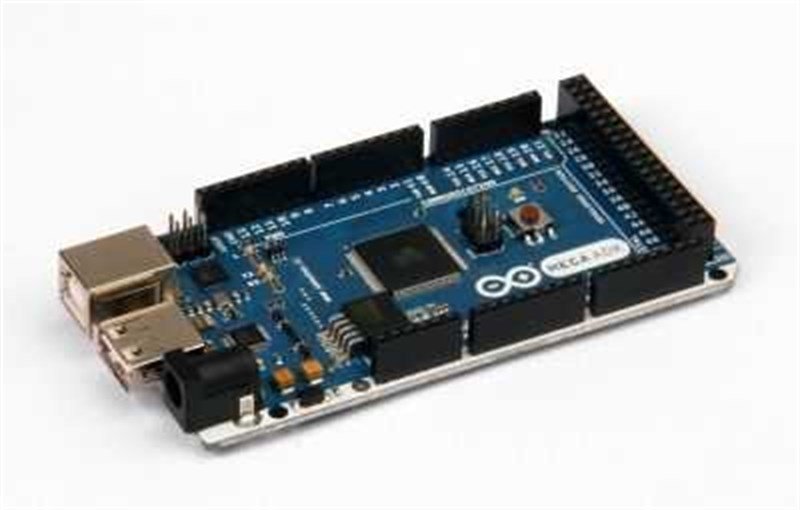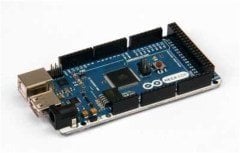Original Arduino Mega ADK (Android Developer Board)
69,00 USD
Arduino Mega ADK is a microcontroller board based on Atmega2560. The board is able to connect android devices via usb host with its MAX3421 IC. There are 54 digital I/O pins (15 of them are PWM out),1 6 analog input pins, 4 UART (physical serial port), a 16 MHz crystal oscilator, an USB socket, a power socket, an ICSP connector and reset button on the board. There are the all essential parts on the board for microcontroller operations. The board can easily be connected to the computer via usb or can be used with an external adapter of battery.
Arduino Mega ADK has an Atmega16u2 (It was Atmega8u2 on the Rev 2 model) usb - serial chip for programming and communicaiton with computer via usb.
Detailed informaiton of the board to use with an android device:
Arduino Library:
You can use Arduino Mega ADK board with the library prepared for Arduino Usb Host Shield.
Features:
- Microcontroller: ATmega2560
- Operating voltage: 5 V
- Supply voltage (recommended): 7-12 V
- Supply voltage (limits): 6-20 V
- Number of digital I/O pins: 54
- Number of PWM pins: 15
- Number of analog input pins: 16
- Max DC current for each I/O pins: 40 mA
- DC current for 3.3 V out: 50 mA
- Max DC current for 3.3 V pin: 1 A (if supplied with an external adapter)
- Flash memory: 256 kB (ATmega2560, 8 kB is used by bootloader)
- SRAM: 8 kB (ATmega2560)
- EEPROM: 4 kB (ATmega2560)
- Clock speed: 16 MHz
- Usb Host Chip: MAX3421E
- Length: 101.6 mm
- Width: 53.4 mm
- Weight: 36 gr
Power:
Arduino Mega ADK can be supplied via usb or an external voltage source. External voltage source would be an AC - DC adapter or a battery. When it is supplied with an external adapter or battery, using 2.1 mm width, center-positive, 7-20 V power supply is recommended. Moreover, the connectors of the power socket on the board, Vin and GND pins are short circuited in beckend. The battery can be connected to the board via GND and Vin pins.
It is not necessary to be connected to usb port during whole the operation. The board can be energized with only an adapter or a battery too, by this way, the board can work independently from the computer.
As Arduino Mega ADK is an usb host, the android device connected to the board, will draw current from Mega ADK. If the Mega ADK is supplied via usb, this means the total current for both the android device and the board is limited with 500 mA. The 5 V regulator on the board can provide DC current up to 1500 mA. If an external power supply is used, the current for the android device can reach maximum 750 mA. If we consider the other I / O pins draws 750 mA together too. It will be better to use a 1.5 A external power supply.
6 - 20 V can be used as an external supply but these are the limits for Mega ADK. Recommanded voltage supply for this board is between 7 - 20 V. Becouse the regulator on the board might not work stabile for the voltages below 7V. Likewise, it can be over - warmed for the voltages above 12 V.
Operating voltage of the Arduino Mega ADK's microcontroller is 5 V. The voltage supplies the board via Vin pin or the power socket on 7 to 12, V then this voltage is regulated and distributed to the board by the regulator.
Power pins are like that:
- Vin: When an external adapter is used, the voltage of the adapter is on this pin. You can supply the board by applying 7-20 V among this pin instead of the on-board power connector.
- 5 V: The 5 V pin on the board is directly connected to the output of the regulator. To supply the board directly from this pin is not recommended due to that this way will not activate the 3.3 V and 5 V regulators on the board. If the board is supplied by usb (5 V), 5 V of the usb directly comes this pin. If the board is supplied by an external power supply or from Vin pin then the voltage of the 5 v pin comes from output of the regulator.
- 3.3 V: 3.3 V out pin from the regulator. Max. current is 50 mA.
- GND: Ground pins on the board.
- AREF: It is possible to change the referance voltage of the board.
Memory:
Atmega2560 has an 256 kB flash memory (8 kB of this is used by the bootloader), 8 kB SRAM and 4 kB EEPROM.
Input and Output:
All of the 54 digital pins on the Arduino Mega ADK board can be configured both as an input or an output. There are 16 analog input pins on the board too. All of these analog pins can be configured as digital input or output. In total there are 70 digital input - output pins on the board. Logic level of these pins are all 5 V. All of these pins are able to provide an output current up to 40 mA. Additionally, some of these pins have diffrent features too, listed below:
- Serial Communication, Serial: 0 (RX) and 1 (TX), Serial1: 19 (RX) and 18 (TX), Serial2: 17 (RX) and 16 (TX), Serial3: 15 (RX) and 14 (TX) : These pins are used to recieve (RX) and Transmit (Tx) TTL data. These pins are directly connected to Atmega16u2 usb - serial converter chip on the Mega ADK board, that means when the board is getting programmed or while the Mega and computer is communicating these pins are in use. Becouse of this situation it is recommended not to use these pins when the other pins are free.
- External Interrupts By using the pins 2 (Interrupt 0), 3 (interrupt 1), 18 (interrupt 5), 19 (interrupt 4), 20 (interrupt 3) and 21 (interrupt 2) you may activate interrupts respect to logic-1 and logic-0 levels and/or rising edge or falling edge. You can find the details on the attachInterrupt() function page.
- PWM: Pins 1 - 13 and 44 - 46 can provide 8-bit analog out using analogWrite() function.
- SPI: 53 (SS), 51 (MOSI), 50 (MISO), 52 (SCK) pins are used for SPI communication.
- USB Host, MAX3421E: With this chip, ADK can communicate via SPI port, so the listed pins below is used.
- Digital 7 (RST), 50 (MISO), 51 (MOSI), 52 (SCK). Please do not use the pin 7 as input or output as it is used for communication.
- Pins wich are not connected to any headers: PJ3 (GP_ MAX), PJ6 (INT_ MAX), PH7 (SS)
- Analog: A0 - A15; Mega ADK board has 16 10-bit analog input pins. These pin may be used also as digital input or output. As default, the referance range of analog inputs is between 0-5 V. This range can be changed by using AREF pin and analogReferance() function.
- I2C, 20 (SDA) pin and 21 (SCL) pin: These pins are used for I2C serial communication.
- AREF: The referance pin for analog input.
- Reset: If logic-0 voltage level applied to this pin, the board resets itself.
- LED: There is an internal LED on the Mega ADK board. This led will blink if logic HIGH applied.
Communication:
There are several options for Arduino Mega ADK to communicate with another arduino or microcontroller. Atmega2560 provides 4 UART TTL (5V) Serial communications via its 0 (RX) and 1 (TX) pins. Atmega2560 connects to a computer by opening a virtual serial COM port and allows the serial communication. Arduino IDE, thanks to its serial monitor find in the computer software, provides to send and recieve text based information. RX and TX leds on the board blink while the board is communicating via USB.
There is a phsycally serial port on the Mega ADK board but this number can be increased with the SoftwareSerial library as software.
Atmega2560 provides I2C and SPI ports too. Wire library if to use I2C and SPI library is for SPI communication.
The usb host interface provided by MAX3421E is used to connect to another devices via usb. These devices are mainly android devices. Additionally the board can connect by the same way to the mouse and keyboard devicez and can control Canon camera too.
Programming:
Arduino Mega ADK board can be programmed with the Arduino computer software (Arduino IDE). You can start programming by choosing Arduino Mega ADK under tools > board menu on the Arduino IDE. For details you may see the referance and the basic functions page. Atmega2560 on the Arduino Mega ADK board comes together with a specific software installed, named bootloader. Thanks to this it is not needed to use an external programming device to program Arduino Mega ADK. Communication is supplied by and original STK500protocol.
The board can be programmed by using ICSP headers via ISP programmer instead of bootloader software (Referance).
Like the bootloader software, the source code in the Atmega16u2 is opensource. This software is named DFU bootloader. This software can be re-uploaded by using Atmel's FLIP software (Windows) or DFU programmer (Mac OS X and Linux) or can be re-programmed with 16u2 and ISP like Atmega2650. Both Atmega2560 and Atmega16u2 comes with the current revisions so it is not needed to chane these codes.
Usb high current protection:
Arduino Mega ADK board has restarable high current protectors. Even if your computer has its own protectors for its USB ports, the protectors on the board is adjusted to reject more than 500mA. If this amount of current is reached, protectors will keep open - circuit the connection untill the short - circuit disappears.
Documents:
- Atmega2560 Datasheet
- Board Schematics
- Eagle PCB Drawing Files
- Arduino Computer Software (Arduino IDE)
- Arduino Page
Be the first to comment on this product!


